FQPF3N90 Specs and Replacement
Type Designator: FQPF3N90
Type of Transistor: MOSFET
Type of Control Channel: N-Channel
Absolute Maximum Ratings
Pd ⓘ
- Maximum Power Dissipation: 43 W
|Vds|ⓘ - Maximum Drain-Source Voltage: 900 V
|Vgs|ⓘ - Maximum Gate-Source Voltage: 30 V
|Id| ⓘ - Maximum Drain Current: 2.1 A
Tj ⓘ - Maximum Junction Temperature: 150 °C
Electrical Characteristics
tr ⓘ - Rise Time: 45 nS
Cossⓘ -
Output Capacitance: 65 pF
RDSonⓘ - Maximum Drain-Source On-State Resistance: 4.25 Ohm
Package: TO-220F
- MOSFET ⓘ Cross-Reference Search
FQPF3N90 datasheet
..1. Size:677K fairchild semi
fqpf3n90.pdf 

September 2000 TM QFET QFET QFET QFET FQPF3N90 900V N-Channel MOSFET General Description Features These N-Channel enhancement mode power field effect 2.1A, 900V, RDS(on) = 4.25 @ VGS = 10 V transistors are produced using Fairchild s proprietary, Low gate charge ( typical 20 nC) planar stripe, DMOS technology. Low Crss ( typical 8.0 pF) This advanced technology has... See More ⇒
8.1. Size:710K fairchild semi
fqpf3n40.pdf 

April 2000 TM QFET QFET QFET QFET 400V N-ChanneI MOSFET GeneraI Description Features These N-Channel enhancement mode power field effect 1.6A, 400V, RDS(on) = 3.4 @VGS = 10 V transistors are produced using Fairchild s proprietary, Low gate charge ( typical 6.0 nC) planar stripe, DMOS technology. Low Crss ( typical 4.2 pF) This advanced technology has bee... See More ⇒
8.2. Size:810K fairchild semi
fqp3n80c fqpf3n80c.pdf 
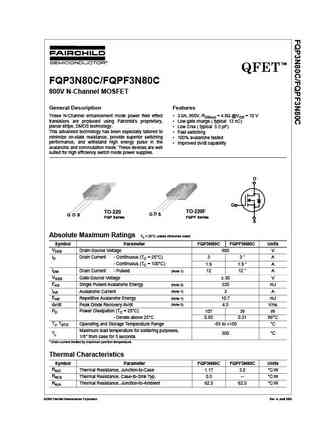
TM QFET FQP3N80C/FQPF3N80C 800V N-Channel MOSFET General Description Features These N-Channel enhancement mode power field effect 3.0A, 800V, RDS(on) = 4.8 @VGS = 10 V transistors are produced using Fairchild s proprietary, Low gate charge ( typical 13 nC) planar stripe, DMOS technology. Low Crss ( typical 5.5 pF) This advanced technology has been especially tailored t... See More ⇒
8.3. Size:638K fairchild semi
fqpf3n80.pdf 

September 2000 TM QFET FQPF3N80 800V N-Channel MOSFET General Description Features These N-Channel enhancement mode power field effect 1.8A, 800V, RDS(on) = 5.0 @VGS = 10 V transistors are produced using Fairchild s proprietary, Low gate charge ( typical 15 nC) planar stripe, DMOS technology. Low Crss ( typical 7.0 pF) This advanced technology has been especially tail... See More ⇒
8.4. Size:717K fairchild semi
fqpf3n30.pdf 
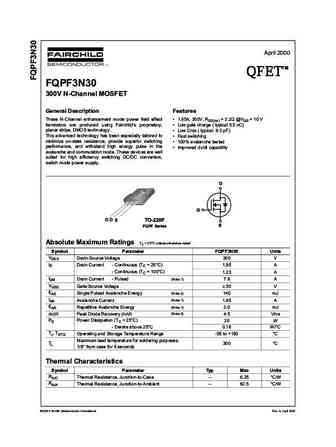
April 2000 TM QFET QFET QFET QFET 300V N-ChanneI MOSFET GeneraI Description Features These N-Channel enhancement mode power field effect 1.95A, 300V, RDS(on) = 2.2 @VGS = 10 V transistors are produced using Fairchild s proprietary, Low gate charge ( typical 5.5 nC) planar stripe, DMOS technology. Low Crss ( typical 6.0 pF) This advanced technology has bee... See More ⇒
8.5. Size:1269K fairchild semi
fqp3n50c fqpf3n50c.pdf 
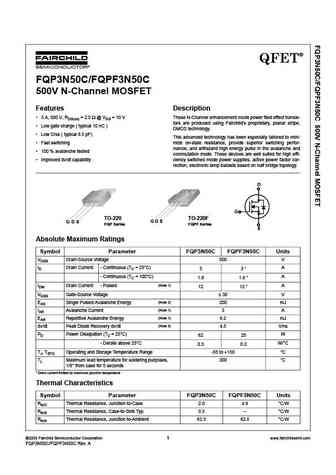
QFET FQP3N50C/FQPF3N50C 500V N-Channel MOSFET Features Description 3 A, 500 V, RDS(on) = 2.5 @ VGS = 10 V These N-Channel enhancement mode power field effect transis- tors are produced using Fairchild s proprietary, planar stripe, Low gate charge ( typical 10 nC ) DMOS technology. Low Crss ( typical 8.5 pF) This advanced technology has been especially tailored to... See More ⇒
8.6. Size:808K fairchild semi
fqpf3n80cydtu.pdf 
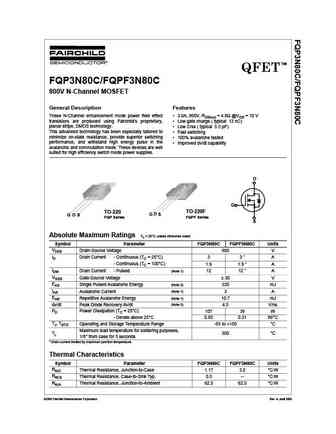
TM QFET FQP3N80C/FQPF3N80C 800V N-Channel MOSFET General Description Features These N-Channel enhancement mode power field effect 3.0A, 800V, RDS(on) = 4.8 @VGS = 10 V transistors are produced using Fairchild s proprietary, Low gate charge ( typical 13 nC) planar stripe, DMOS technology. Low Crss ( typical 5.5 pF) This advanced technology has been especially tailored t... See More ⇒
8.7. Size:555K fairchild semi
fqpf3n60.pdf 
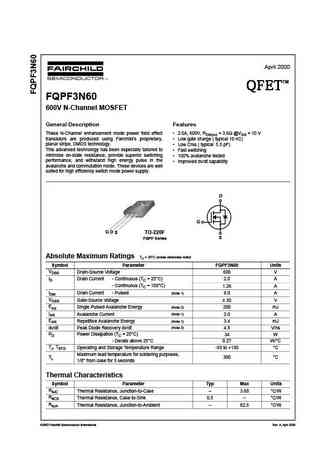
April 2000 TM QFET QFET QFET QFET FQPF3N60 600V N-Channel MOSFET General Description Features These N-Channel enhancement mode power field effect 2.0A, 600V, RDS(on) = 3.6 @VGS = 10 V transistors are produced using Fairchild s proprietary, Low gate charge ( typical 10 nC) planar stripe, DMOS technology. Low Crss ( typical 5.5 pF) This advanced technology has been e... See More ⇒
8.8. Size:1267K fairchild semi
fqp3n50c fqpf3n50c.pdf 
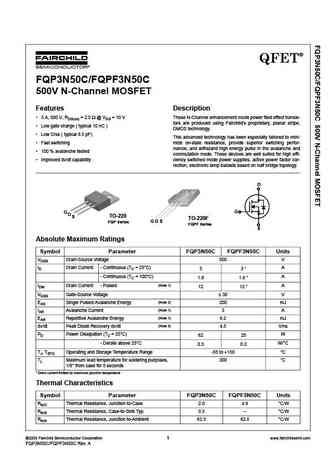
QFET FQP3N50C/FQPF3N50C 500V N-Channel MOSFET Features Description 3 A, 500 V, RDS(on) = 2.5 @ VGS = 10 V These N-Channel enhancement mode power field effect transis- tors are produced using Fairchild s proprietary, planar stripe, Low gate charge ( typical 10 nC ) DMOS technology. Low Crss ( typical 8.5 pF) This advanced technology has been especially tailored to... See More ⇒
8.9. Size:724K fairchild semi
fqpf3n25.pdf 
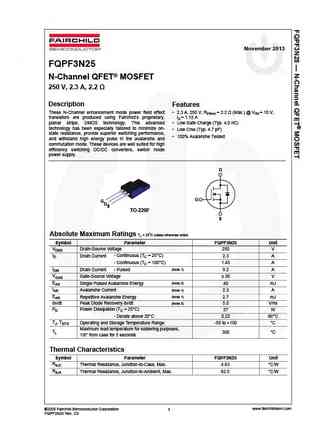
November 2013 FQPF3N25 N-Channel QFET MOSFET 250 V, 2.3 A, 2.2 Description Features These N-Channel enhancement mode power field effect 2.3 A, 250 V, RDS(on) = 2.2 (Max.) @ VGS = 10 V, transistors are produced using Fairchild s proprietary, ID = 1.15 A planar stripe, DMOS technology. This advanced Low Gate Charge (Typ. 4.0 nC) technology has been especially tailored... See More ⇒
8.10. Size:883K onsemi
fqp3n80c fqpf3n80c.pdf 

Is Now Part of To learn more about ON Semiconductor, please visit our website at www.onsemi.com Please note As part of the Fairchild Semiconductor integration, some of the Fairchild orderable part numbers will need to change in order to meet ON Semiconductor s system requirements. Since the ON Semiconductor product management systems do not have the ability to manage part nomenclatur... See More ⇒
8.11. Size:892K onsemi
fqpf3n25.pdf 

Is Now Part of To learn more about ON Semiconductor, please visit our website at www.onsemi.com Please note As part of the Fairchild Semiconductor integration, some of the Fairchild orderable part numbers will need to change in order to meet ON Semiconductor s system requirements. Since the ON Semiconductor product management systems do not have the ability to manage part nomenclatur... See More ⇒
Detailed specifications: FQPF34N20, FQPF34N20L, FQPF3N30, FQPF3N40, FQPF3N50C, FQPF3N60, FQPF3N80, FQPF3N80CYDTU, RU7088R, FQPF3P20, FQPF3P50, FQPF44N08, FQPF44N08T, FQPF44N10, FQPF46N15, FQPF47P06YDTU, FQPF4N20
Keywords - FQPF3N90 MOSFET specs
FQPF3N90 cross reference
FQPF3N90 equivalent finder
FQPF3N90 pdf lookup
FQPF3N90 substitution
FQPF3N90 replacement
Learn how to find the right MOSFET substitute. A guide to cross-reference, check specs and replace MOSFETs in your circuits.












